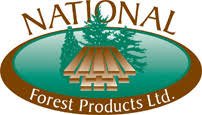
Fence Post Surface Textures
Western Red Cedar posts are available in Clear and Knotty product standards. Clear posts have a limited number of natural characteristics and should be specified when you want fence posts of the finest appearance. For a more casual, rustic fence, specify Knotty posts. The different surface textures of the wood are summarized following:
Fence Rails
Western Red Cedar lumber for fence rails is available in a range of sizes in Clear and Knotty product standards or grades. You also have a choice or rough or surfaced textures. The different surface textures of the wood are summarized following:
Saw Textured
The textured surface, obtained during the milling process which uses either circular or band saws, present on all four sides.
Rougher Headed
The lumber receives its texture from a milling process which uses roughened planer knives. The rough texture is clearly visible on all four sides.
Surfaced Four Sides (S4S)
The smooth surface on all four sides presents a uniformly sized product with a high quality appearance. If you want surfaced four sides (S4S) fence rails, you may also consider specifying WRCLA Decking Product Standards Architect Clear, Custom Clear, Architect Knotty or Custom Knotty.
Surfaced One Side, Two Edges (S1S2E)
This popular product lets you build a fence with either the rough sawn or surfaced face exposed to your view. The surfacing process provides uniform width and thickness tolerances.
Rough Sawn/Rougher Headed
The lumber receives its texture from a milling process which uses either circular or band saws or roughened planer knives. The rough texture is clearly visible on all four sides. Rough lumber would be your best choice for a rustic style fence.
Fence Specifications & Grades
Fence Grading Rules
Grading Rule Paragraph:
4″ Posts (102 mm)
NLGA 122 b,c
WCLIB 122 b,c
WWPA 40.11, 40.12
6″ & Larger Posts (152 mm)
NLGA 131 a,b,c
WCLIB 131 a,b,cc
WWPA 80.10, 80.11, 80.12
NLGA - National Lumber Grades Authority
WCLIB - West Coast Lumber Inspection Bureau
WWPA - Western Wood Products Association
Sizes
Fence Posts
The most common sizes of fence posts are 4″ x 4″ and 6″ x 6″ either rough sawn or dressed (see below).
| Thickness and Width | |||||
|---|---|---|---|---|---|
| Nominal (in.) | Nominal (mm) | Rough (in.) | Rough (mm) | Dressed (in.) | Dressed (mm) |
| 4 | 102 | 3-3/4 | 101 | 3-9/16 | 90 |
| 6 | 152 | 5-3/4 | 146 | 5-1/2 | 140 |
Fence Rails
The most common sizes of cedar fence rails are 2″ x 4″ and 2″ x 6″ (See below).
| Thickness and Width | |||||
|---|---|---|---|---|---|
| Nominal (in.) | Nominal (mm) | Rough (in.) | Rough (mm) | Dressed (in.) | Dressed (mm) |
| 2 | 51 | 1-3/4 | 44 | 1-9/16 | 40 |
| 4 | 102 | 3-3/4 | 101 | 3-9/16 | 90 |
| 6 | 152 | 5-3/4 | 146 | 5-1/2 | 140 |





